Basic Information on the Minolta SR mount:
The Minolta SR mount was introduced in 1958, together with the Minolta SR-2 SLR, making it one of the earliest bayonet mounts for an SLR camera. That Minolta was earlier that its competition in launching its own mount is best exemplified by that initially not all Minolta SR lenses facilitated auto aperture.
Like many of the lens mounts of the era (60’s–80’s), it went through several iterations during its existence, gradually incorporating new features. This article will try to briefly encompass the development of the SR mount.
Minolta SR mount specifications
Mount type: Male-type bayonet (lens release on body)
Flange focal distance: 43,71 mm
Film format: 36mm x 24mm (‘Full frame’)
Mount communication: depending on which generation of SR mount:
• SR manual and preset: none
• SR auto: aperture stop-down (body-to-lens)
• MC: aperture stop-down (body-to-lens); selected aperture (lens-to-body)
• MD: aperture stop-down (body-to-lens); selected aperture (lens-to-body); minimum aperture (lens-to-body)
• X-600: as MD + maximum aperture class (lens-to-body)
See further details below.
History of the SR (/MC, MD) mount
From the relative obscurity of Chiyoda Kogaku in 1958, Minolta SR mount cameras and lenses raised the company to the forefront of 35 mm photography in less than three decades. When Minolta (in 1985) introduced the world’s first functional body-driven autofocus system, few pundits were really that surprised that Minolta beat its competition to the punch. The dedication, ingenuity and workmanship displayed by Minolta in these three decades were admired widely – not only by the millions of customers, but also by several competitors (most notably, Leica. See more here and here, or in the December 2011 issue of Amateur Photographer).
Among the SR/MC/MD line of lenses and bodies, there are many notables (too many to mention). Suffice it to say, that you do not need to be a Minolta fanboy to appreciate the gear.
But, Minolta’s reaching for new heights with the launch of its line of autofocus cameras and lenses was the undoing of the SR lens mount. Alike some of its fiercest rivals, Minolta decided to pursue autofocus based on an entirely new lens mount. Moreover, due to the difference in flange focal distance between the Minolta SR mount (43,72 mm) and its successor, the Minolta A-mount (44,5 mm), SR-mount lenses could not be adapted to the new bodies (as manual focus lenses) without either losing infinity focus or having to use an adapter with optics. Those Minolta SR users who had a sizeable investment in SR/MC/MD lenses were left high-and-dry. To say that Minolta’s move lost them a lot of goodwill, would be a sizeable understatement.
Then again, there is little reason to suspect this to have had a significant influence on Minolta’s ultimate demise two decades later, as Canon did precisely the same (orphaned it’s FD-users) when shifting to a new autofocus mount and managed to come out on top (although the transition was not smooth).
SR mount – Variants and generations
However, it is important to note that the Minolta SR mount introduced in 1958 did not remain unchanged until 1985 – on the contrary, several additions and extensions were built in during those decades, and for those additions to be able to work they also needed lenses to be consecutively redesigned. That forms the basis of the three major variants (SR (auto), SR/MC and SR/MD) of the Minolta SR mount.
Further, Minolta also was not immune to the vagaries of fashion or industrial design, which means that within these major variants there are often clear aesthetic, ergonomic or functional generations. These will be detailed in the following headings. Note please that the given timespans are indicative, as Minolta would typically exhaust its inventory of parts before launching a new design to market.
Minolta SR (manual, preset and auto) (1958–1966)
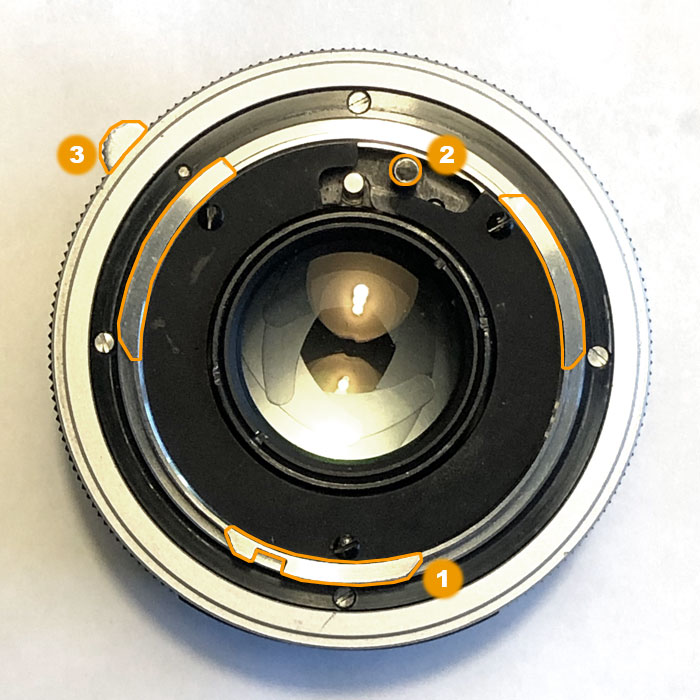
At its most basic, the Minolta SR bayonet mount is characterized only by a three-pronged bayonet that has a locking notch at 6:30 o’clock [1]. As the SR bayonet initially also included the provision for using preset lenses, the aperture stop-down lever [2] and depth-of-field preview lever [3] are optional.
Incidentally, the operating principle of the SR mount’s auto aperture is that (when the lens is mounted on the body) the body keeps the aperture open, and on taking the picture, the body releases the aperture stop-down lever, thereby allowing a spring to pull the aperture closed to the user-selected value. The addition of a depth-of-field preview lever on some Minolta SR lenses was to allow depth-of-field preview independent of the camera body having that functionality. On progressing to the SR/MC mount, the dept-of-field preview lever was dropped.
Generations
• SR Preset lenses (1958–1966) Longer and wider lenses as well as specialty lenses were initially introduced as preset lenses, and while some if these were replaced with auto aperture lenses early on, others stayed in the lineup until 1966.
• AR I (1958–1960) AR stands for Auto-Rokkor, and these are the earliest auto aperture lenses for the Minolta SR system. They’re easy to characterise by that the “LENS MADE IN JAPAN” is absent from the lens name ring and distances between aperture markings on the aperture ring are not constant. Many lenses had a chrome front to allow for clamp-on lens shades.
• AR II (1961–1964) These were the next iteration of Auto-Rokkors, and featured a redesigned aperture mechanism (even distances). Fronts would still be chromed but the name ring would now contain the “LENS MADE IN JAPAN”.
• AR C (1965–1967) C stands for Compact, as many of these lenses would be redesigns of existing lenses aiming for greater compactness. Far from all lenses were redesigned. The chrome fronts were dropped.
Minolta SR/MC (1966–1976)
While the SR mount facilitate auto aperture (and thereby wide-open composing and focusing) any metering would have to be done through stop-down metering because the lens had no reliable way to communicate the selected aperture value to the camera body. To facilitate this, Minolta in 1966 extended the SR mount with a functionality referred to as MC (stands for meter coupling).
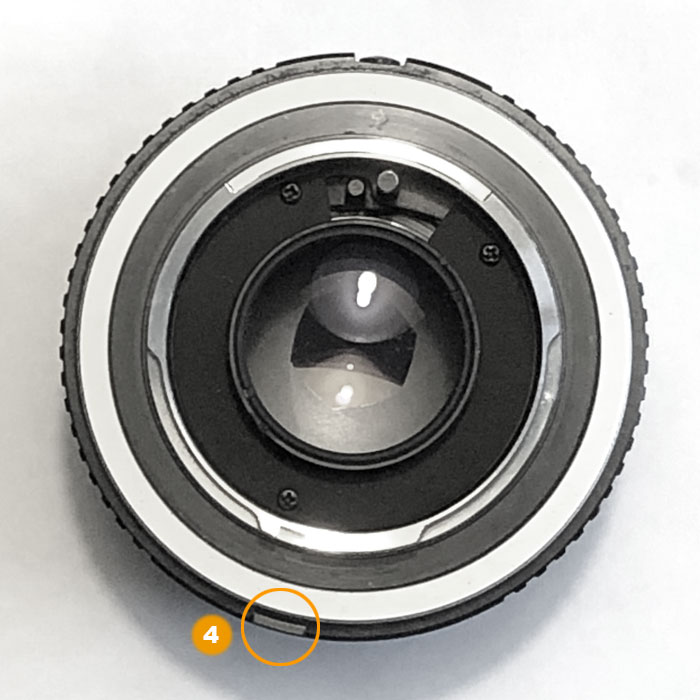
Meter coupling is a simple and elegant solution, wherein the aperture ring is given a prong [4] that extends towards the camera body, that interfaces with a similar prong mounted on the camera-end of the mount, thereby allowing the camera to – at all times – know what aperture the user has set the lens. Note that the location of the prong (at 6:30 o clock in this picture) is not an identifier, as the prong moves together with the aperture ring. If you need to identify a Minolta MC lens and do not have access to imagery of the lens’ mount, all Minolta MC lenses have the phrase MC on the lens’ name ring.
Generations:
• MC I (1966–1969) Typically silver aperture rings, metal focusing rings. The MC I generation can be discerned by that the ribbed sections of the focus rings are on “plains” and not in “valleys”
• MC II (1969–1972) Still silver aperture rings, still metal focus rings, but now the ribbed sections of the focus rings would typically be situated in a “valley” between ridges. Aslo sometimes referred to as ‘short grip’ because the grippable section of the focus ring would be narrower than on MC I lenses.
• MC X (1973–1976) So named because since 1973 Rokkor lenses sold in America would be called ‘ROKKOR-X’. Rubberised focus rings. Introduction of the ‘red bead’ (a red, plastic semi-sphere to indicate lens mounting orientation on the lens between aperture and focus ring).
Minolta SR/MD
While meter coupling (SR/MC) not only allowed fully open metering (metering without needing to stop down the lens), it also allowed the further construction of camera bodies that could do aperture priority auto exposure. But to be able to facilitate shutter priority one crucial bit of information was missing, namely a way for the lens to communicate its minimum aperture (f/16, f/22 or /f32).
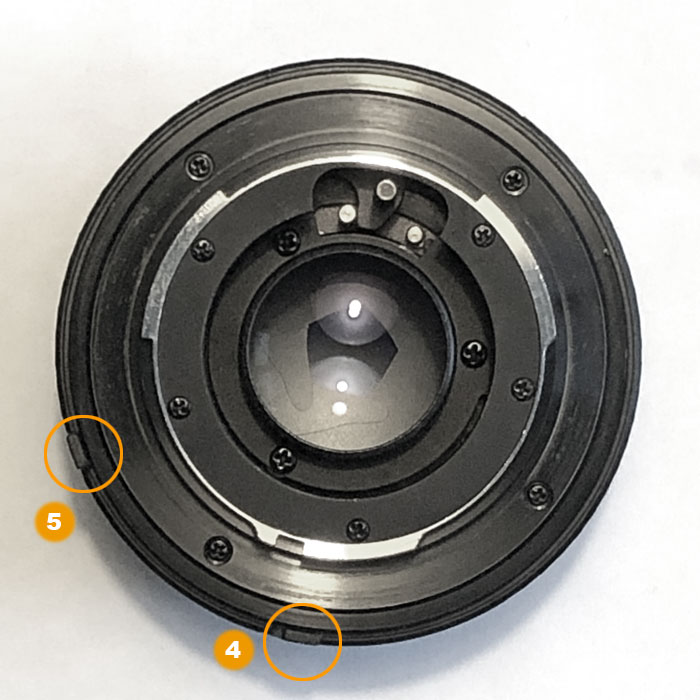
To enable this, another small tab (the MD tab) was added to the aperture ring in 1977, that communicates the minimum aperture to any camera equipped to ‘read’ it. If you need to identify a Minolta MD lens and do not have access to imagery of the lens’ mount, all Minolta MD lenses have the phrase MD on the lens’ name ring.
When Minolta later introduced camera bodies that also featured program auto, this could work with any MD lens, but as a the penultimate of the MD lens lineup, lenses were equipped with a pusher mechanism to lock the aperture ring at its minimum aperture (see below).

Generations:
• MD I (1977) These were an intermediate version consisting mostly of whatever modifications had to made to an MC-X lens to technically make it MD-compatible. Identifiable by that the lens name ring a) has the phrase ‘MD’ and b) lacks information of the filter thread diameter.
• MD II (1978–1980) This line introduced major optical and mechanical redesigns to a large range of lenses. Identification rule: the lens name ring a) has the phrase ‘MD’, b) has information of the filter thread diameter and c) has the “LENS MADE IN JAPAN” phrase.
• MD III (1981–1984) This line offered a small pusher to lock the aperture ring at minimum aperture, the focus ring grip pattern was changed and many lenses were redesigned for compactness. Identification rule: the lens name ring a) has the phrase ‘MD’, b) has information of the filter thread diameter and c) lacks the “LENS MADE IN JAPAN” phrase.
• MD IIIa (1985–1996) Lenses introduced after Minolta’s main focus had shifted to autofocus. Mostly made by third parties and often not considered to be on the same level as earlier lenses. Lacks the red bead, does not have the aperture lock pusher.
Special-purpose variations:
Minolta SR/X-600
In 1983 – already preparing for the autofocus revolution – Minolta introduced a camera (the Minolta X-600) that allowed focus confirmation (A green dot would appear in the viewfinder whenever the body thought the centre point was in focus). While The X-600 in the end was a one-off and was never marketed outside of Japan (my guess is Minolta decided to bet the farm on full autofocus cameras, and as we know, that turned out to be a good bet), it seems that there was a point in time when Minolta was quite serious about focus confirmation as a technology.
Because for focus confirmation to be reliable, the body needed information on roughly what the lens’ maximum aperture was (something even MD spec did not reveal), and – without any great announcement – Minolta started equipping new SR/MD lenses with a pin to communicate that.
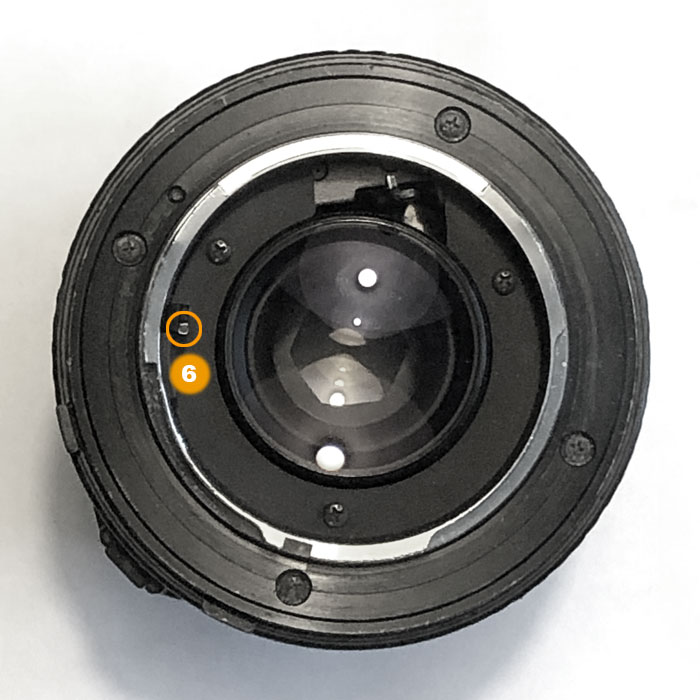
It is however noteworthy, that Minolta did not go all-out on indicating maximum aperture. Instead, the X-600 indicator pin has only two possible positions: One for lenses that have a maximum aperture of f/2.8 or faster; one for lenses that have a maximum aperture of f/3.5 or lower. Seemingly, this was quite sufficient.
CELTIC
In 1972 Minolta introduced a line of budget lenses for the North American market, which were named CELTIC (either MC CELTIC or MD CELTIC depending on generation). As a funny quirk, Celtic lenses were offered both in the 28–35 mm focal length range and the 135–200 mm range, but the only lens between 35 and 135 mm was a 50 mm macro.
SR/MC/MD/X-600/CELTIC – compatibility
Photographic lenses are expensive paperweights without a camera that can make use of them. The same goes for all the elements of a lens’ interfaces. Due to the manner in which Minolta implemented the extensions of the original Minolta SR mount, forward- and backward compatibility was almost total: An MD body could use an SR lens as well as an SR body could have, while MD lenses could be mounted on MC-and SR -age bodies without issues. Considering the manner in which some of Minolta’s competitors stumbled with retaining compatibility, this is no small feat.
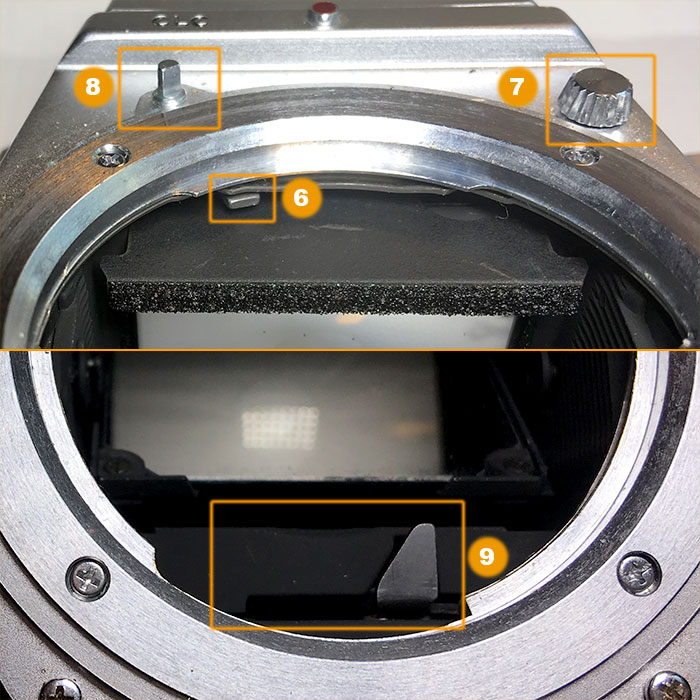
[6] Locking pin that interfaces with locking notch.
[7] Lens release button (push down to raise locking pin)
[8] Meter coupling pin. Interfaces with MC prong on lens. (MD pin not in picture, as no MD-enabled body on hand.)
[9] aperture stop-down lever, activated both by shutter and depth-of-field preview button.
Adapting Minolta SR/MC/MD lenses
Yes please, thank you very much. Or maybe not. It depends.
The first is definitely true on mirrorless Interchangeable Lens Cameras. Due to their fully-manual nature, Minolta SR lenses – of every variant – function beautifully (but manually) on mirrorless cameras using a simple dumb adapter. Having been designed for 35 mm film, the combination is – naturally – at its smoothest on full-frame mILC’s , but even with APS-C and MFT mILC’s the marriage is not necessarily problematic: You either gain some ‘zoom’ (crop factor) or employ a focal reducer. Compared to e.g. Konica AR lenses, the availability of focal reducers for Minolta SR lenses is a big plus.
Moreover, there are several accounts (here and otherwhere) pointing to that a decent number of Minolta SR lenses actually have image circles big enough to manage to cover the sensor of digital medium format cameras.
On dSLR’s the second (maybe not) is sadly true. With a relatively short flange focal distance (43,5 mm) the Minolta SR mount does not lend itself well to adapting on dSLR’s. In fact, the only dSLR with a shorter flange focal length than that is the (no longer manufactured) Olympus four thirds system, but that still means incurring a significant (potentially unwanted) crop factor. Otherwise, the alternative of using an adapter with optics remains, but is far from perfect.
Read more:
Minolta SR lens index on minolta.eazypix.de
Rokkorfiles.com